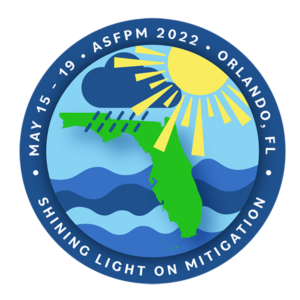I recently returned from attending the Association of State Floodplain Managers (ASFPM) annual conference in Orlando. I’d been waiting to attend a conference this year and ASFPM's is usually my top pick. It's not a large conference, where one may get lost in myriad topics and talks, but rather intimate and familiar, offering immense opportunity to network and hear from the best. The 2022 ASFPM Conference was also a record-breaker in terms of attendance, featuring a virtual option in addition to the in-person activities.

Five full days of intellectual and social engagement brought together the largest congregation of flood experts from all over the United States. Discussions included plans, programs, policies, grants, and of course, the devasting losses to life and property caused by floods in our country each year. It became a great meeting place for federal, state, and local officials, consultants and contractors—who all share one goal—to reduce the risk of flooding in our communities.
Plenaries included the discussion of new approaches to managing risk, such as from the perspective of the National Wildlife Federation and Fannie May (HUD), as well as remarks from Florida’s US Representative, Kathy Castor; Partners in Flood Risk Management; and top officials from FEMA and NOAA.
David Maurstad, Acting Associate Administrator of Resilience at FEMA Headquarters, spoke at a luncheon session. While he elaborated on FEMA’s continuing efforts to reduce risk, he underscored the importance of addressing flood risk at the community level.
Sessions covered just about every flood risk management category: Flood Insurance, Mitigation Planning, Flood Damage Assessment, Mapping, Risk Communications, Local Climate Change Initiatives, Equitable Floodplain Management, Resiliency and Climate Adaptation Planning, Floodplain Management Legislation and Policy, and FEMA’s flood-related programs and grants.
Of particular interest to me was understanding the change in Risk Rating 2.0 and what floodplain managers need to know about FEMA’s Mitigation Planning policies, as well as adapting the National Flood Insurance Program for a changing climate. Risk Rating 2.0 is FEMA’s new pricing methodology for flood insurance premiums. Rates take into account flood frequency, type of flooding (coastal, riverine, etc.), distance to a water source, and the cost to rebuild the property. The changes to Risk Rating 2.0 are aimed at being actuarily sound and equitable, which I agree with: that folks with high value properties should be paying higher premiums. More information can be found at https://www.fema.gov/flood-insurance/risk-rating.
I attended a session that introduced ASFPM’s new tool, https://www.reducefloodrisk.org/, that enables people to understand their flood risk and protect their property from future flooding. This library of flood mitigation strategies and resources is particularly useful for property owners and buyers to examine mitigation actions that are based on your home or property type. A nice handy-dandy tool!
I was also interested in the discussion about FEMA’s requirement for local governments to address the risks posed by high hazard potential dams (HHPD) in their 5-year hazard mitigation plan updates or as an amendment to the hazard mitigation plan. Planners and engineers, get ready for more work on HMPs.
It wasn't all talks and training sessions, though—these folks know how to have fun. Both fitness freaks and casual walkers attended an early morning 5KRun/Walk before the Florida sun emerged. The silent auction held in the exhibit hall was enticing and offered a range of goodies, from bourbon and books to a trip to Miami. There was something for everyone in that room. I pictured myself lying on the sands of South Beach, pina colada and all, but someone else was the lucky winner!
On a social note, we were happy to hug and bump fists and elbows and see each other in person for the first time in three years. I have been religiously attending this conference for the last 20 years but this time around, I found a sense of excitement and exuberance to meet, greet, learn, collaborate, partner and of course, eat and drink, like never before. The most beautiful part of this—none of us had aged!
Deepa Srinivasan, CFM, AICP
President - Vision Planning and Consulting